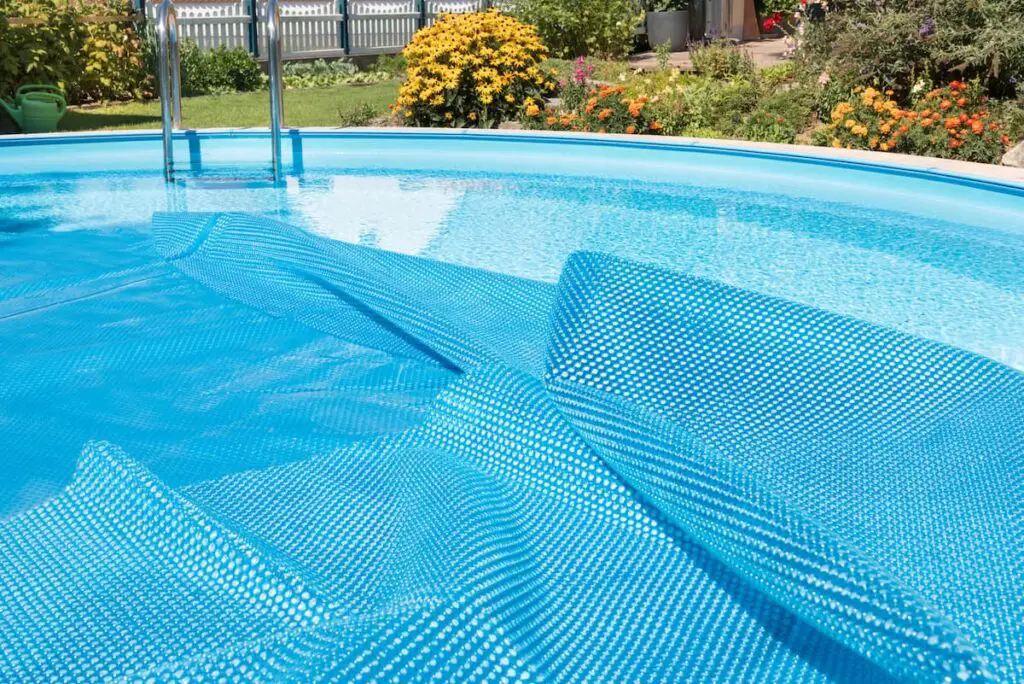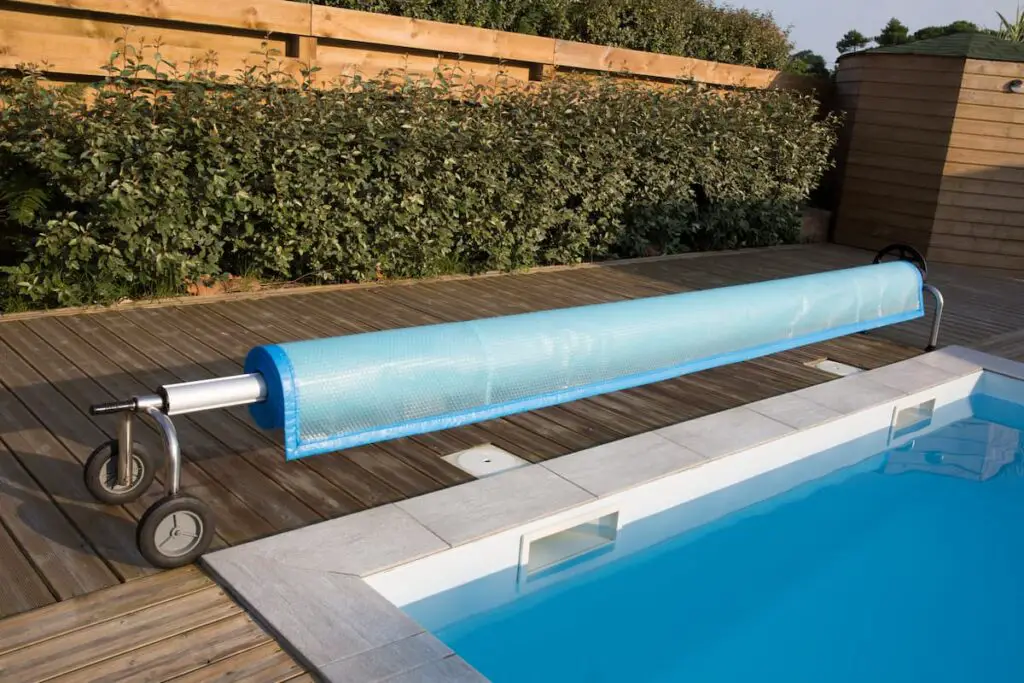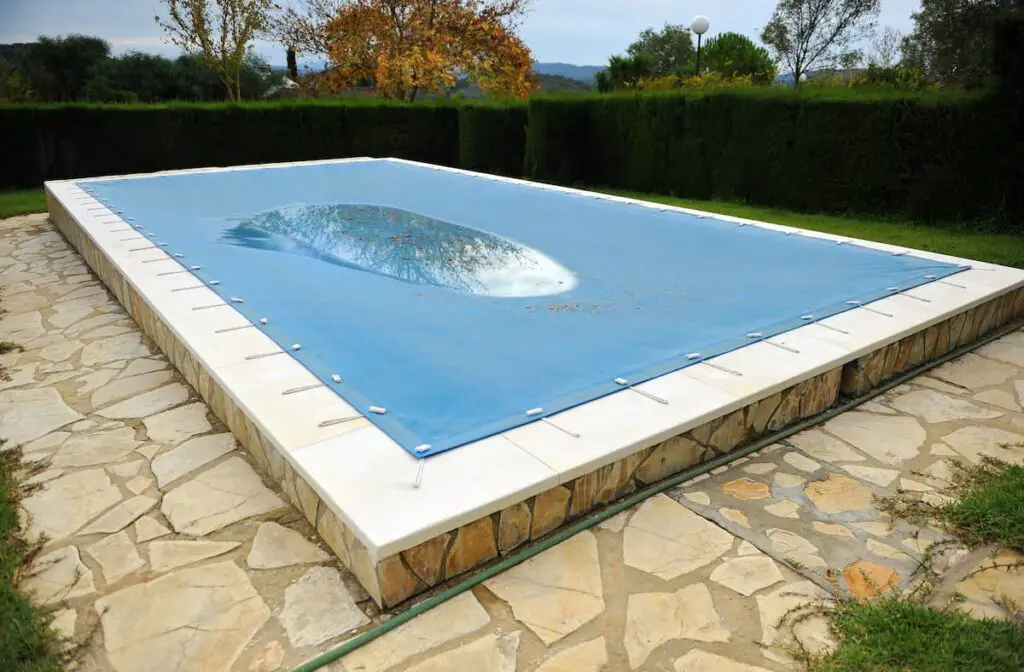As an Amazon Associate, we earn from qualifying purchases. We may also earn commissions if you purchase products from other retailers after clicking on a link from our site.
Covering your pool keeps debris and trash out, but keeping the pool cover on is a challenge, especially when the wind gets under the cover. So what can be done to keep the wind blowing over instead of under a roof cover?
To keep wind from blowing under a pool cover, you should install the cover securely. Then use a tool to assist in keeping the cover on, such as a pool air pillow, cover clips, or additional weights. You can also use water tubes and winter cover seals to keep wind from blowing underneath.
After you go through the work of winterizing your pool and putting the cover on, you don’t want the cover to be blown away. Luckily, there are several options that will help keep the cover on.

Why You Don’t Want Wind Blowing Under the Pool Cover
If this is your first winter with a pool, you might be wondering what’s the big deal with wind blowing under the cover. Imagine that the pool cover is a giant sail that you have placed over the pool.
A sail uses wind to move objects like boats and windsurfers. Should wind get under the pool cover and it gets loose, you essentially have a loud sail whipping in the wind. In a worst-case scenario, the cover gets tangled in tree branches or other sharp objects, and it is then ruined.
Use a Pool Air Pillow
Air pillows are used in pool covers to prevent a solid ice layer from forming on the water’s surface. Place them in the pool’s center before installing the pool cover.
An air pillow also protects your pool’s cover and walls by minimizing the force of freezing and thawing. In addition, since an air pillow compresses as the water in your pool freezes, it eases the strain on the pool walls.
Tip: Since frozen water expands by 9%, you should ideally buy enough air pillows so they can cover roughly 10% of the surface.
Install a Pool Cover
Installing a pool cover can be a breeze or a pain. If you toss the cover in the water and attempt to install it haphazardly, the process will be frustrating. Instead, follow the steps below for a less stressful install.
- Turn off your pump. If you don’t turn it off, it might pull the cover under the water.
- Determine where the wind is coming from. Start installing the pool cover from that side. Otherwise, your cover will act like a sail and fly upward at the first gust.
- Tie down the cover. Ensure you have tied it tightly to prevent it from coming undone.
- Work your way around the pool. Undo the cover as you go and fold the edges over the lip of the pool.
- If you notice the pool cover coming loose where you tied it, work your way over to a spot directly opposite of where you tied down the cover. Loosely tie down that side with a half knot and then continue bringing the cover to the edge of the pool.
- Expect the cover to loosen until you get in place and ready for the final tie-down. Once the cover is on, tie it down securely.
A pool pillow and a securely tied pool cover might be good enough if you live in an area that rarely gets wind gusts.

Use Cover Clips
Cover clips are one of the easiest and most cost-effective ways to keep high winds from blowing your pool cover off in heavy winds. Cover clips are specialized tension clips designed for above-ground pool coverings.
They are simple to use. All you need to do is fasten the clips to your pool’s top rail, with the cover pinched in between.
These may be purchased at your local pool supply store or online. They come in various sizes based on the size of your above-ground pool.
Cover clips can also keep pool covers from the weight of excessive rainwater.
Use Water Tubes
Swimming pool water tubes are constructed of durable vinyl that can withstand winter temperatures. Look for tubes with UV inhibitors in the vinyl to keep it from breaking down. It should also have antibacterial and antifungal agents to protect the water from nasty fungus and bacteria.
Water tubes sit on the cover’s edges to keep it in place during strong winds or heavy rain/snowfall. They are easy to install. Some pool covers have water tube loops, so connecting the tubes will be easy.
If your cover doesn’t have such ties, you should buy double-channel tubes.
Avoid filling the tubes since there needs to be room for expansion, so only fill the tubes ½ to ¾ full. In addition, a small amount of antifreeze in the tubes can help prevent freeze damage.
Wrap a Winter Cover Seal Around the Pool
A Winter Cover Seal is a strong film you wrap around your pool. It is another level of protection for those who endure strong winds or harsh winter weather.
Think of winter cover seals as extremely durable plastic wrap. This product creates an airtight seal, making it difficult for wind to get under the pool. The Gladon Winter Cover Seal (available on Amazon.com) wraps around a 24-foot (7.32 meter) pool six times. The product is relatively inexpensive, and installation is easy.

Use Additional Weights
By additional weights, we don’t mean cinder blocks, coffee cans filled with rocks or pebbles, or bricks to hold a winter pool cover down. Doing so can be dangerous, especially to someone who accidentally falls into the pool.
Heavy-duty vinyl wall bags, such as the Robelle Deluxe Wall Bag (available on Amazon.com), are attached to the cover at the pool’s edge. To use the bags, fill them halfway with water so the bags don’t burst when the water freezes. Then fasten them to the cover. Even in windy conditions, these water bags will keep your cover in place.
Check Your Pool Periodically
Yes, you have covered your pool, and you won’t be able to swim in it until spring, but you still need to check your pool periodically. Don’t just set your cover and forget it.
You should check on the cover a couple of times a month. You may want to tighten the cover, seal wind gaps, and move the air pillow if needed. A fast check takes only a few minutes, but it can save you the expense of repairs.
Winterize Your Pool
If you live in a climate with freezing temperatures, frost, and snow, you should winterize your pool. Doing so reduces the chances of water contamination and cold damage to your equipment.
A well-covered pool that is not winterized will cause you time and frustration in the spring. These are some basic steps to take.
The best time to start winterizing is when the temperature falls below 65 degrees Fahrenheit (18 degrees Celsius).
- Gather your winterizing kit, which should include pH and alkalinity, and calcium hardness increasers. You also need algaecide as part of your kit.
- Get together the rest of your supplies. This includes your pool cover, but you also want to have the accessories for tying down the cover.
- Clean your pool. Vacuum it, brush down the walls, and skim leaves and other debris from the surface.
- Test and balance your water. Follow directions on your increases to get your pH level between 7.4 and 7.6 and your chlorine level three parts per million.
- Keep your pump from freezing. First, remove the hoses from the filter, drain them, and store them in a warm, dry place. Additionally, make sure you remove drain plugs from the pump and filter and follow any other winterization steps for your filter.
Bottom Line
Use a combination of several accessories to ensure that your pool cover stays in place, starting with an air pillow. If you live in a windy area, consider using a secondary add-on to supplement the tie-downs that come with the cover.
